
Erotica is literature or art that deals substantively with subject matter that is erotic, sexually stimulating or sexually arousing. Some critics regard pornography as a type of erotica, but many consider it to be different. Erotic art may use any artistic form to depict erotic content, including painting, sculpture, drama, film or music. Erotic literature and erotic photography have become genres in their own right. Erotica also exists in a number of subgenres including gay, lesbian, women's, bondage, monster and tentacle erotica.

Heterosexuality is romantic attraction, sexual attraction or sexual behavior between people of the opposite sex or gender. As a sexual orientation, heterosexuality is "an enduring pattern of emotional, romantic, and/or sexual attractions" to people of the opposite sex; it "also refers to a person's sense of identity based on those attractions, related behaviors, and membership in a community of others who share those attractions." Someone who is heterosexual is commonly referred to as straight.

A lesbian is a homosexual woman or girl. The word is also used for women in relation to their sexual identity or sexual behavior, regardless of sexual orientation, or as an adjective to characterize or associate nouns with female homosexuality or same-sex attraction. The concept of "lesbian" to differentiate women with a shared sexual orientation evolved in the 20th century. Throughout history, women have not had the same freedom or independence as men to pursue homosexual relationships, but neither have they met the same harsh punishment as gay men in some societies. Instead, lesbian relationships have often been regarded as harmless, unless a participant attempts to assert privileges traditionally enjoyed by men. As a result, little in history was documented to give an accurate description of how female homosexuality was expressed. When early sexologists in the late 19th century began to categorize and describe homosexual behavior, hampered by a lack of knowledge about homosexuality or women's sexuality, they distinguished lesbians as women who did not adhere to female gender roles. They classified them as mentally ill—a designation which has been reversed since the late 20th century in the global scientific community.

Eroticism is a quality that causes sexual feelings, as well as a philosophical contemplation concerning the aesthetics of sexual desire, sensuality, and romantic love. That quality may be found in any form of artwork, including painting, sculpture, photography, drama, film, music, or literature. It may also be found in advertising. The term may also refer to a state of sexual arousal or anticipation of such – an insistent sexual impulse, desire, or pattern of thoughts.

A sexual fantasy or erotic fantasy is an autoerotic mental image or pattern of thought that stirs a person's sexuality and can create or enhance sexual arousal. A sexual fantasy can be created by the person's imagination or memory, and may be triggered autonomously or by external stimulation such as erotic literature or pornography, a physical object, or sexual attraction to another person. Anything that may give rise to a sexual arousal may also produce a sexual fantasy, and sexual arousal may in turn give rise to fantasies.

Erotic art is a broad field of the visual arts that includes any artistic work intended to evoke erotic arousal. It usually depicts human nudity or sexual activity, and has included works in various visual mediums, including drawings, engravings, films, paintings, photographs, and sculptures. Some of the earliest known works of art include erotic themes, which have recurred with varying prominence in different societies throughout history. However, it has also been widely considered taboo, with either social norms or laws restricting its creation, distribution, and possession. This is particularly the case when it is deemed pornographic, immoral, or obscene.

Erotic literature comprises fictional and factual stories and accounts of eros intended to arouse similar feelings in readers. This contrasts erotica, which focuses more specifically on sexual feelings. Other common elements are satire and social criticism. Much erotic literature features erotic art, illustrating the text.

Henry Spencer Ashbee was a book collector, writer and bibliographer. He is notable for his massive, clandestine three-volume bibliography of erotic literature published under the pseudonym of Pisanus Fraxi.

Homoeroticism is sexual attraction between members of the same sex, including both male–to–male and female–to–female attraction. The concept differs from the concept of homosexuality: it refers specifically to the desire itself, which can be temporary, whereas "homosexuality" implies a more permanent state of identity or sexual orientation. It has been depicted or manifested throughout the history of the visual arts and literature and can also be found in performative forms; from theatre to the theatricality of uniformed movements. According to the Oxford English Dictionary, it is "pertaining to or characterized by a tendency for erotic emotions to be centered on a person of the same sex; or pertaining to a homo-erotic person."

Lesbian erotica deals with depictions in the visual arts of lesbianism, which is the expression of female-on-female sexuality. Lesbianism has been a theme in erotic art since at least the time of ancient Rome, and many regard depictions of lesbianism to be erotic.

Lesbianism is the sexual and romantic desire between women. There are historically fewer mentions of lesbianism than male homosexuality, due to many historical writings and records focusing primarily on men.

Erotic horror, alternately called horror erotica or dark erotica, is a term applied to works of fiction in which sensual or sexual imagery are blended with horrific overtones or story elements for the sake of sexual titillation. Horror fiction of this type is most common in literature and film. Erotic horror films are a cornerstone of Spanish and French horror.
"Compulsory Heterosexuality and Lesbian Existence" is a 1980 essay by Adrienne Rich, which was also published in her 1986 book Blood, Bread, and Poetry: Selected Prose 1979-1985 as a part of the radical feminism movement of the late '60s, '70s, and '80s.
The Romance of Lust, or Early Experiences is a Victorian erotic novel written anonymously in four volumes during the years 1873–1876 and published by William Lazenby. Henry Spencer Ashbee discusses this novel in one of his bibliographies of erotic literature. In addition the compilers of British Museum General Catalogue of Printed Books list this book.

Bisexual erasure, also called bisexual invisibility, is the tendency to ignore, remove, falsify, or re-explain evidence of bisexuality in history, academia, the news media, and other primary sources.

The history of erotic depictions includes paintings, sculpture, photographs, dramatic arts, music and writings that show scenes of a sexual nature throughout time. They have been created by nearly every civilization, ancient and modern. Early cultures often associated the sexual act with supernatural forces and thus their religion is intertwined with such depictions. In Asian countries such as India, Nepal, Sri Lanka, Japan and China, representations of sex and erotic art have specific spiritual meanings within native religions. The ancient Greeks and Romans produced much art and decoration of an erotic nature, much of it integrated with their religious beliefs and cultural practices.
Women's erotica is any erotic material that caters specifically to women target-demographic of various sexual preferences. When erotica is specifically directed at lesbians, it is referred to as lesbian erotica. Women's erotica is available from a variety of media including video games, websites, books, comics, short stories, films, photography, magazines, audio, anime and manga. The content may cover many aspects of sexuality, from relationships to fetishes; the main idea being to convey sex-positivism from a woman's perspective, or to feature female empowerment and sexual fantasies.
Feminist sexology is an offshoot of traditional studies of sexology that focuses on the intersectionality of sex and gender in relation to the sexual lives of women. Sexology has a basis in psychoanalysis, specifically Freudian theory, which played a big role in early sexology. This reactionary field of feminist sexology seeks to be inclusive of experiences of sexuality and break down the problematic ideas that have been expressed by sexology in the past. Feminist sexology shares many principles with the overarching field of sexology; in particular, it does not try to prescribe a certain path or "normality" for women's sexuality, but only observe and note the different and varied ways in which women express their sexuality. It is a young field, but one that is growing rapidly.

Sex in film, the presentation of aspects of sexuality in film, specially human sexuality, has been controversial since the development of the medium. Films which display or suggest sexual behavior have been criticized by religious groups or have been banned or censored by governments, although attitudes have changed much along the years and a more permissive social environment has developed in certain parts of the world, notably in Europe, North America, Australia and New Zealand. In countries with a film rating system, films which contain explicit sex scenes typically receive a restricted classification. Nudity in film may be regarded as sexual or as non-sexual.

Compulsory heterosexuality, often shortened to comphet, is the theory that heterosexuality is assumed and enforced upon people by a patriarchal and heteronormative society. The term was popularized by Adrienne Rich in her 1980 essay titled "Compulsory Heterosexuality and Lesbian Existence". According to Rich, social science and literature perpetuate the societal belief that women in every culture are believed to have an innate preference for romantic and sexual relationships with men. She argues that women's sexuality towards men is not always natural but is societally ingrained and scripted into women. Comphet creates the belief that society is overwhelmingly heterosexual and delegitimizes queer identities. As a result, it perpetuates homophobia and legal inequity for the LGBTQ+ community.

















